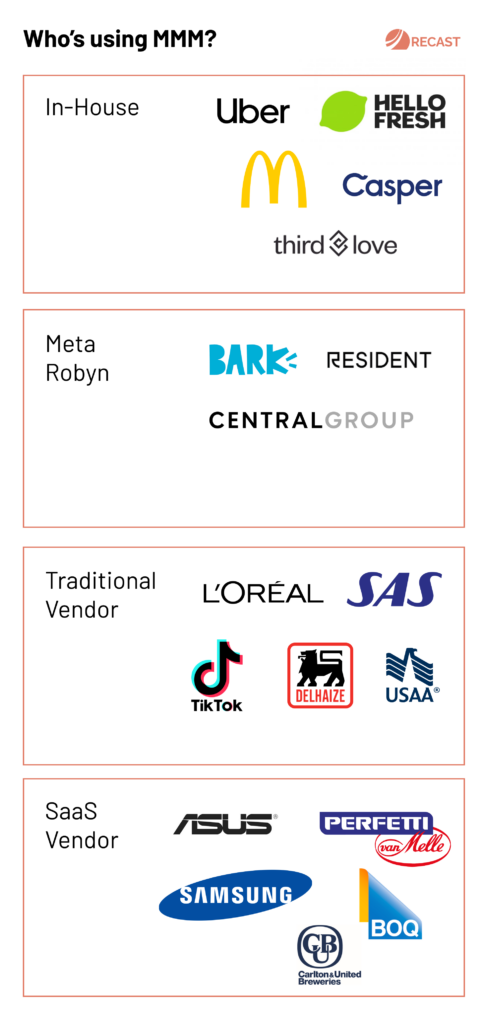Brands have been using models to understand the effectiveness of their marketing activities since the ‘Golden Era’ of advertising in the 1960s. However, as our history of Econometrics details, the dawn of the internet era and digital marketing in the early 2000s moved Marketing Mix Modeling (MMM) out of the hands of the select few fortune 500 companies, and into the mainstream as part of an industry-wide focus on measurement and optimization.
It is widely assumed that with this rich history many of the largest brands are long established in deploying MMM. But as barriers to entry of using these tools come down, adoption amongst smaller organizations that could have previously not afforded MMM is increasing.
This post explores which brands, both large and small, are publicly talking about how they use MMM and the different approaches they take. The goal is to bring together a bank of examples that can be useful to others who are embarking on a journey through marketing measurement. We encourage readers to submit other examples through this form so we can enlarge this database of brands and keep it up to date going forward.
Editor’s note: Yes, we know we’re linking to a lot of competitors here! That’s fine by us; Recast won’t be the right solution for everybody. The real thing all of us are fighting against is inertia: brands hoping and dreaming that multi-touch attribution isn’t broken, or that they can put off investing in MMM.
Which brands are using MMM?
A few hours of desk research uncovered a wide range of brands who are publicly sharing their approaches to MMM, including many DTC brands and some of the top spending global consumer brands. It is important to remember, just because a brand is not listed here does not mean they are not using MMM, they may just not be talking about it.
These examples fell into four ‘buckets’:
- Those who build custom in-house MMM tools.
- Those who have experimented with integrating Meta’s Robyn open-source package into their in-house approaches.
- Those who engage a ‘traditional’ MMM vendor, such as Neilsen or Neustar.
- Those who use automated MMM software vendors, such as Recast, Keen, or Mutinex.

Sources: Casper, HelloFresh, ThirdLove, Uber, McDonalds, Resident, Central Retail Corporation, BARK, SAS, USAA, TikTok,L’Oréal, Perfetti van Melle, Samsung, CUB, Bank of Queensland Group, ASUS, Delhaize
Who is building in house MMM solutions?
Overall, the majority of brands that we found to be talking about building in house solutions are DTC brands. This comes as no surprise as DTC brands depend on data to disrupt traditional business models, so they often invest in building in-house expertise to manage and optimize data. This is not to say ‘traditional’ brands are not building in-house solutions, McDonalds is a large brand we found that did speak publicly about using this approach.
Casper
Casper spoke in 2019 about using a collaborative and iterative process to combine revenue models, MMM and MTA in-house to measure performance and create media mix optimization. Casper emphasized how “There is no one-size-fits all solution” to attribution and media mix optimization. They suggest the best approach is to start somewhere, iterate and continue to improve.
HelloFresh
HelloFresh’s 2020 Medium post gives a detailed overview of the MMM model they built in-house, using Bayesian techniques to build a regression model with multiple variables, including marketing spend They were also able to incorporate known concepts, such marketing spend saturation, advertising decay, and the marketing funnel hierarchy into the model. HelloFresh’s approach to modeling the funnel effects is notable, where they split the approach into two steps. In the first step, named the ‘direct model’, only the upstream channels are modeled to ensure they have the chance to receive credit for the downstream impact they might have had. The second step, the ‘undirect model’ the same set of channels is used to model the weekly spend (not conversions) for the downstream channels, and the coefficients obtained from this lower-funnel model reveal how much marketing spend from the top of the funnel is absorbed by these channels at the bottom. HelloFresh explain their focus on making practical and adaptable MMM models that they expect to continue to iterate and evolve over time.
ThirdLove
ThirdLove released a detailed white paper in 2019 entitled ‘Building and Validating Media Mix Models’, where they specify using a combination of click attribution to observe trends, an in-house MMM to estimate marginal cost and forecast acquisition and experimentation to validate the MMM. Specifically, they use the BSTS R package to determine the model parameters. Using a synthetic data set to illustrate, ThirdLove outlines the importance of validating models to understand the data beyond just predicting customer acquisitions based on marketing spend, validation with click attribution and holdout tests is necessary. Again there is an emphasis on iteration, “the only solution [for the marketing data scientist] is to keep tracking, keep testing, and to keep updating the models as more time goes by.”
Uber
Uber’s Applied Science team released an academic paper in 2021 that introduces a Bayesian Time Varying Coefficient (BTVC) model specifically designed for MMM applications at Uber. This model incorporates a hierarchical Bayesian structure and weights coefficients based on local latent variables that follow specific probabilistic distributions. To estimate the posteriors of both the latent variables and dynamic coefficients, Uber used Stochastic Variational Inference (SVI). This proposal provided a solution to the challenges faced by traditional MMM approaches, and also outperformed them in terms of accuracy and interpretability during simulations and experiments conducted on real-world marketing data sets.
McDonald’s
This 2020 interview with a data scientist from McDonald’s posted on Proof’s website details how since 2017 they have, with the help of analytic firms as partners, been building an internal MMM, revamping data inputs and pulling in new data. This model is used alongside MTA, though the MTA and MMM models are not mixed, they are used to validate each other. This new approach meant the model could be run more frequently, as Alexandra Gaski from McDonald’s outlines, “automating certain parts of the model allowed us to run MMM quarterly instead of annually which has resulted in way better and accurate findings.”
Who is trialing Meta’s Robyn with their in-house solutions?
As this post explains, Meta released Robyn, an open-source library with the goal of automating MMM to reduce human bias in 2021. Since its launch, three case studies have been released by Meta to show how brands are trialing Robyn alongside in-house solutions.
Resident
Resident is the parent group of brands such as mattress brands Nectar and DreamCloud. Resident’s data-science team experimented by running their previously built in-house MMM in parallel with Robyn in 2020. Specifically, “Resident customized the Robyn code with its own requirements and then began running both marketing mix modeling solutions side by side, every month.” The two models produced similar results, validating Robyn and leading the Resident team to consider moving entirely to Robyn in the future, following some further validation.
Central Retail Group
Central Retail Group, a leading Thai retail conglomerate with over 80,000 employees, used Robyn to analyze campaigns from January 2019 onwards, which created insights on how to reallocate budget to increase revenue by up to 28%. Gustavo Bramao, Group Marketing Director, Central Retail said, “We believe the Robyn framework is the most advanced and intuitive applied marketing mix modeling model we could deploy in-house. The code is intelligible, well-documented and allows flexible hyper-parameterisation as well as calibration of estimates with incremental lift studies, Ridge regression, Prophet for modeling the baseline and predictive budget optimisation. With Robyn, we have a robust source of truth to inform our budget allocation decisions”.
BARK
BARK, the parent company of BarkBox and other dog centric products, wanted to assess its customer acquisition costs in a uniform manner across various channels. Additionally, it aimed to comprehend how non-spend variables, such as press releases, news blurbs, BARK’s website content, and promotional offers, affect subscription rates. Data scientists at BARK used Robyn’s codebase to build a MMM in 2021. This Robyn-fuelled in-house solution took three months to build and generated a 30% increase in overall subscriptions.
Who engages a ‘traditional’ MMM vendor?
The brands who are publicly talking about engaging a ‘traditional’ MMM vendor tend to be larger, more corporate, organizations. Again, it is important to remember that there are many other companies not listed here who are very likely to be working with these types of vendors, this list represents those we could find publicly discussing their approach.
SAS
Scandinavia’s biggest airline, SAS, partnered with Neustar in 2019 to engage the Neustar MMM. This regression model assessed the effect of media channels, non-media marketing strategies (including pricing, inventory, customer satisfaction, competitor actions, economic factors, and more) on sales, as well as other key performance indicators (KPIs), within a unified analytical framework. This created a data-driven guide to spend and optimization, resulting in a 38% increase in marketing influenced revenue, despite 20% budget cuts. Furthermore, the MMM interface allows SAS to “conduct quarterly budgeting and media planning based around the impact of specific media investments on its total revenues and brand-related KPIs.”
USAA
USAA is the financial products and services company offered to US military personnel. This 2019 case study outlines how partnering with Neustar allowed USAA to leverage MMM in conjunction with A/B testing to develop an overall measurement approach named ‘Informed Attribution’. This combined approach helped establish the approach internally: “By leveraging and combining the strengths of both analytic techniques, MMM’s measurement of media effectiveness is enhanced and USAA’s confidence in the results has increased. This, in turn, ensures that MMM remains an effective and robust solution to inform and enable decision-making throughout the organization.”
TikTok
TikTok commissioned a syndicated MMM study with Nielsen to help TikTok CPG advertisers understand the impact of TikTok ad products on their sales. This is a slightly different example where TikTok is not seeking to optimize their own marketing spend, rather they are leveraging MMM as a privacy-safe way to prove the impact of their solutions to their clients. Jorge Ruiz, Head of Measurement at TikTok said “In a privacy-centric world, MMMs are seeing a strong resurgence. As clients continue to work on improving ROI for their campaigns, we are glad to partner with Nielsen who has built robust insights to perform better while proving TikTok drives sales impact.”
L’Oréal
In this 2018 post on Think with Google, it is outlined how L’Oréal worked with Ekimetrics to conduct a MMM study on the hair care brand Elvive in the Middle East, which helped fine tune the optima media allocation across channels. Marwan Moubarak, L’Oreal’s Marketing Manager for the Middle East explained why they took this approach, “We decided to do marketing mix modeling to better understand the ROI on each touchpoint and see where we can optimize,” he continued, “It is important to evaluate the strategy we have put in place and make the necessary adjustments when needed. ROI is a very important factor that we are focusing on more and more, marketing mix modeling is a great tool for an optimized, sustained way of working.”
Delhaize
Delhaize is a Belgian supermarket chain that partnered with Gain Theory to deploy MMM to optimize media plans and campaigns, measure marketing performance and prove the effectiveness of marketing activity internally. Annelore Van Hove, Head of Media & Channel at Delhaize, emphasized the importance of data to help with these objectives, “I always say that marketing is not an exact science, but we’re trying to base it more on facts and figures and be more analytical,”. This data-led approach resulted in a 60% increase in ROI, and an increased media budget in 2022 compared to 2023.
Who engages MMM software vendors?
The brands we could find that were talking about using MMM software vendors were surprisingly large corporations in established sectors such asCPG and technology. Many of these newer MMM vendors did not have many case studies available, perhaps an indication of the challenges in getting clients to talk publicly about partnerships with these more recent entrants to the MMM space.
Perfetti van Melle
Candy manufacturer, Perfetti van Melle, which owns brands such as Airheads and Mentos, leveraged Keen’s models to predict the financial impact of its media channels, and optimize a weekly media plan in near real-time for the first time. Bill Mackison, Director, Business Analytics and Insights, Perfetti Van Melle explained the impact of the model on the business, “We’re using better data, and that’s leading to better decisions. Instead of just market pre-tests, we can look at actual performance data in evaluating our campaign creative… Instead of planning with data that is 6-24 months old, we’re working with data that is just 45-90 days old.” This approach led to an 82% lift in marketing contribution and $27.4m in revenue opportunity.
Samsung, Carlton & United Breweries and Bank of Queensland Group
In this 2022 Mi3 article and accompanying podcast, three of Mutinex’s clients come together to discuss the benefits of using smarter, dynamic, models that can be connected to sales in the long term.
Carl Bunn, Samsung Head of Corporate Marketing, found particular value of using MMM to understand beyond short term goals, “One of the more interesting conversations I find about MROI is the short and the long conversation – the value of brand versus the value of short-term sales lead activities. It’s on us to continue to find opportunities for those conversations and find the supporting data. But we’ve made good headway – and tools like Mutiny’s are really empowering the team.”
Megan Quinn, CUB Senior Manager for Data and CX, explained how moving away from static, manual data collection that was only available on a quarterly basis towards a dynamic model has benefitted the organization, “What we’ve seen with WarChest … is that you have models that actually empower you to make decisions – because they’re dynamic. You input the data and within five days you have an analysis of your last month [of media investment performance], which means you can test things and iterate. That has been really empowering for businesses, and it also helps build belief because you can see the impact of your decisions.”
ASUS
ASUS, a computer and phone hardware company, partnered with Facebook and Analytic Edge in Vietnam to test MMM in 2018 and 2019. Rather than a traditional MMM study, ASUS trained its internal analytics team to use MMM SaaS to develop and execute models, which created an overall more efficient and scalable approach. It took ASUS’s analytics team six months to undergo training and gather data for the pilot test, which was subsequently concluded within a span of two weeks.
What did we learn from this?
The overall theme from looking at each of the brand’s approaches is that every one of them is enjoying some clear and measurable benefit from using MMM. However, it is noteworthy that none of them claim to have entirely solved the challenge of measuring and optimizing marketing activity. Instead, there is agreement that MMM models need to evolve and adapt as we learn more about how best to utilize them.
Furthermore, it is apparent that there is no one-size-fits-all solution, as building an MMM solution in-house may work best for those with internal expertise, while an off-the-shelf solution may suit those lacking internal capabilities. Bringing together this list of brands talking about MMM has created a fascinating insight into the different ways modern marketers are leveraging MMM. But this is just the beginning- we would love to expand this list to be more comprehensive and act as a resource for the industry. Again, we encourage any readers who have other examples to share to submit them here.
If you’d like to chat about how Recast can help your brand eliminate wasted marketing spend and find true incrementality, let’s talk.



